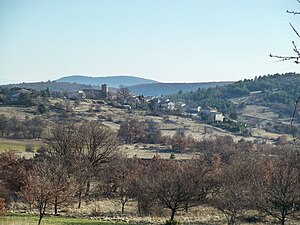L'Hospitalet
| L'Hospitalet | ||
|---|---|---|

|
|
|
| region | Provence-Alpes-Cote d'Azur | |
| Department | Alpes-de-Haute-Provence | |
| Arrondissement | Forcalquier | |
| Canton | Reillanne | |
| Community association | Haute-Provence Pays de Banon | |
| Coordinates | 44 ° 5 ' N , 5 ° 42' E | |
| height | 779-1,632 m | |
| surface | 19.35 km 2 | |
| Residents | 90 (January 1, 2017) | |
| Population density | 5 inhabitants / km 2 | |
| Post Code | 04150 | |
| INSEE code | 04095 | |
 Village view |
||
L'Hospitalet is a French municipality with 90 inhabitants (at January 1, 2017) in the department of Alpes-de-Haute-Provence in the region Provence-Alpes-Cote d'Azur . Administratively it is assigned to the canton of Reillanne and the Arrondissement of Forcalquier .
geography
The small mountain village is a scattered settlement with 90 inhabitants (as of January 1, 2017). It lies at the foot of the Montagne de Lure mountain range 40 kilometers west of Digne-les-Bains and can only be reached from the south either from Saumane or from Lardiers via the forked D12 departmental road.
The municipal area also includes the hamlets of Les Girons , Champ de l'Amant and Les Anglars , as well as the mountain top Le Narreteau (1,486 meters) and the Col Saint-Vincent pass .
The climate is Mediterranean , but the village is very exposed to the Mistral .
economy
The few families in the municipality live mainly from tourism and the production of lavender oil , Banon cheese and honey ( Miel de Provence ). In addition, sheep rearing ( Agneau de Sisteron AOC ) operated.
history
The village with the Latin name Castrum de Hospitalariis (also Hotpitalatum ) was founded around the year 1200 on the initiative of the Order of Malta Hospitaliers, also known as the " Order of the Hospital of St. John in Jerusalem ". Two years are given in old sources as the date of foundation: 1160 and 1250, whereby the former is more likely. If so, then L'Hospitalet goes back to the friars of Manosque . In the middle of the 13th century, the Order of Malta founded a parish and a leper colony in Lardiers . The lords of Simiane , who already owned the Saumane fief , exercised worldly power . The place was insignificant. At the end of the 15th century there were only two taxable households ( feu fiscaux ) and perhaps ten residents in L'Hospitalet .
In modern times the community was able to buy itself out and became independent. During the French Revolution, the residents formed a "local political club of the Jacobins ." At that time around 225 people lived in L'Hospitalet. From the middle of the 19th century this number decreased continuously.
Eight residents of the village died in the First World War . In the 1960s, the high command of the Force de frappe above L'Hospitalet on the Plateau d'Albion began setting up one of their command posts, but after a budget cut the work was stopped after a few years. Today you can only see a big gaping hole on the western slope of the Gardette to which a slope leads.
coat of arms
Blazon : in the head of the shield a golden pole on green ; In the golden base of the shield a green wyvern (also called viper, French guivre ).
Population development
| year | 1954 | 1962 | 1968 | 1975 | 1982 | 1990 | 1999 | 2009 | 2016 |
|---|---|---|---|---|---|---|---|---|---|
| Residents | 57 | 32 | 49 | 33 | 52 | 58 | 78 | 89 | 90 |
Attractions
The parish church of Saint-Jean-Baptiste (' John the Baptist ') is essentially from the 13th century. Some of the remains are from the 12th century and still come from the first church built by the Knights of St. John . The apse , covered with a hemispherical vault ( cul-de-four ), is illuminated by four small windows and closes directly to the outside with the straight facade wall ( chevet plat ). The nave is provided with loopholes and has a single bay . The choir houses a side chapel in the north. The hired bell tower dates from the 17th century. The building was restored in the 19th century.
Individual evidence
- ↑ JJM Féraud: Les Alpes-de-Haute-Provence - Géographie historique et biographie du département des Basses-Alpes , p. 399. New edition Res Universis, Paris, 1992.
- ^ A b Raymond Collier: La Haute-Provence monumentale et artistique , pp. 93, 141. R. Collier, 1986.
- ↑ a b Patrick Saletta: Haute Provence et Vaucluse - Les Carnets du patrimoine . Guides Massin, Editions C. Massin, 2000.
- ↑ a b c d e Patrick Ollivier-Elliott, Caroline Bujard and Marie-Odile Arnoux: Terres de Sault, d'Albion et de Banon , p. 155f. Édisud, Aix-en-Provence, 1996.
- ^ Jean-Joseph-Maxime Feraud: Histoire géographique et statistique du département des Basses-Alpes , p. 614. Vial, 1861.


